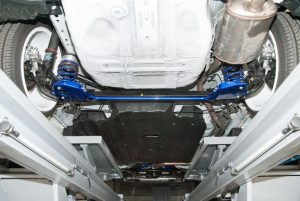Sway bars — also called anti-roll bars or stabilizer bars — are essential components that control body roll during cornering. While they may seem simple, their influence on vehicle balance is significant. By adjusting the stiffness of the front or rear sway bar, drivers can fine-tune how the car behaves in turns, reducing understeer, sharpening response, or correcting oversteer.
Whether you drive a daily commuter, sports car, or off-road vehicle, understanding how sway bars affect handling is key to achieving predictable, stable, and safe performance.
If you’re looking to replace or upgrade your stabilizer system, you can Buy Stabilizer & Components online from trusted suppliers.
What a Sway Bar Does

A sway bar connects the left and right sides of the suspension, resisting independent movement. When the vehicle leans into a corner, the bar twists and pushes the inside suspension down, decreasing body roll.
Main functions:
-
Reduces excessive leaning in corners
-
Distributes load across the axle
-
Improves steering stability
-
Enhances grip balance between wheels
-
Allows suspension to react more consistently
The stiffness of the bar influences how much weight transfers from one side of the vehicle to the other, altering understeer and oversteer tendencies.
How Sway Bars Influence Understeer and Oversteer
Understeer
Understeer occurs when the vehicle turns less than the driver intends — the front tires lose grip first.
Increasing front sway bar stiffness increases understeer, as more load transfers to the outside front wheel.
Oversteer
Oversteer means the rear of the vehicle steps out — the rear tires lose grip first.
Increasing rear sway bar stiffness increases oversteer, as the outside rear wheel is overloaded.
Effects of Sway Bar Tuning
General Effects Table
| Adjustment | Result | Handling Effect |
|---|---|---|
| Stiffer Front Bar | Less body roll at front | More understeer |
| Softer Front Bar | More front grip | Less understeer |
| Stiffer Rear Bar | Reduced rear roll | More oversteer |
| Softer Rear Bar | Increased rear grip | Less oversteer |
Signs Your Sway Bars Need Adjustment
-
Excessive lean while cornering
-
Slow steering response
-
Tail-happy or unstable rear end
-
Car pushes wide on turns
-
Uneven tire wear
-
Suspension feels unbalanced after upgrades
Tuning Tips: How to Achieve the Balance You Want
1. To Reduce Understeer
-
Soften the front sway bar
-
Stiffen the rear sway bar
-
Increase front tire grip (pressure, alignment, tire compound)
2. To Reduce Oversteer
-
Soften the rear sway bar
-
Stiffen the front sway bar
-
Increase rear tire grip
3. For Neutral Handling
Aim for a setup where front and rear roll stiffness complements each other.
Balanced tuning offers:
-
Predictable corner entry
-
Stable mid-corner control
-
More traction on exit
-
Reduced tire stress
Practical Tuning Scenarios
Daily Driving
Goal: comfort, safety, predictable behavior
Recommended: slightly stiffer front bar, mild rear bar
Sport or Performance Driving
Goal: responsive steering, reduced roll, sharper turn-in
Recommended: stiffer rear bar, medium-stiff front bar
Track Use
Goal: maximize grip and steering precision
Recommended: adjustable sway bars on both axles for fine tuning
Real-World Example: Sway Bar Tuning Outcomes
| Setup | Front Bar | Rear Bar | Result |
|---|---|---|---|
| Factory Balanced | Medium | Medium | Neutral, safe |
| Performance Street | Medium-Stiff | Stiff | Faster cornering, mild oversteer |
| Comfort Focused | Soft | Medium | Stable, mild understeer |
| Track-Optimized | Stiff | Very Stiff | Sharp turn-in, rotates aggressively |
Why Quality Sway Bars Matter

Poor-quality or worn sway bars and bushings can lead to:
-
Noisy, clunky suspension
-
Delayed steering response
-
Reduced stability on highways
-
Dangerous handling when cornering
For long-lasting performance and safe driving, always choose OE-quality or premium aftermarket stabilizer components. You can Buy Stabilizer & Components online to ensure compatibility and reliability.
Conclusion
Sway bars play a crucial role in shaping how your vehicle handles. By adjusting front and rear bar stiffness, you can significantly influence understeer or oversteer, customize road feel, and boost driving confidence. Whether you’re tuning for daily comfort or preparing for a track day, understanding sway bar dynamics helps you achieve the perfect balance.
For upgrades, repairs, or full suspension tuning, always choose durable, high-quality parts from reputable suppliers — your handling and safety depend on it.